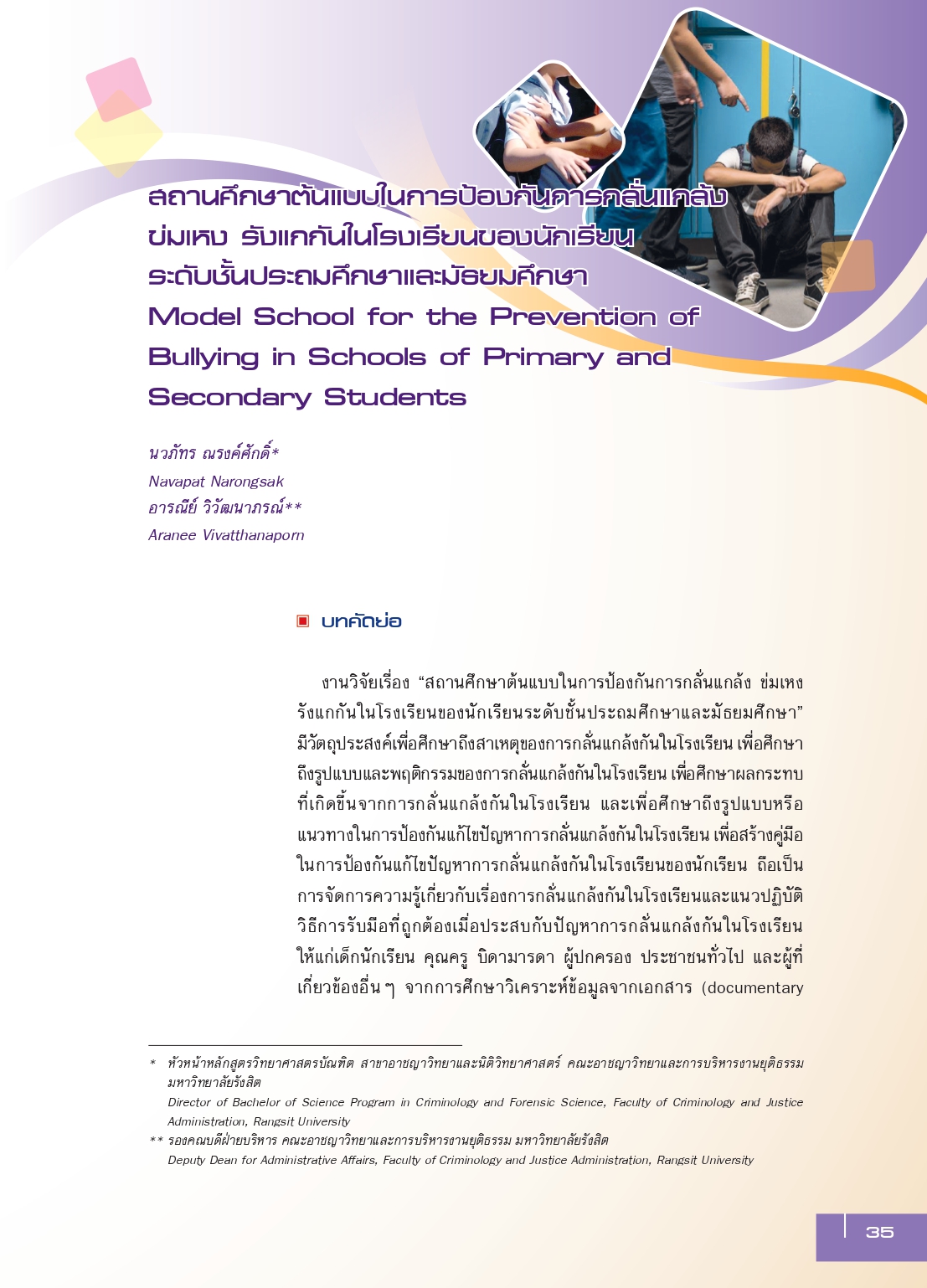สถานศึกษาต้นแบบในการป้องกันการกลั่นแกล้ง ข่มเหง รังแกกันในโรงเรียนของนักเรียน ระดับชั้นประถมศึกษาและมัธยมศึกษา
Main Article Content
บทคัดย่อ
งานวิจัยเรื่อง “สถานศึกษาต้นแบบในการป้องกันการกลั่นแกล้ง ข่มเหง รังแกกันในโรงเรียนของนักเรียนระดับชั้นประถมศึกษาและมัธยมศึกษา” มีวัตถุประสงค์เพื่อศึกษาถึงสาเหตุของการกลั่นแกล้งกันในโรงเรียน เพื่อศึกษาถึงรูปแบบและพฤติกรรมของการกลั่นแกล้งกันในโรงเรียน เพื่อศึกษาผลกระทบที่เกิดขึ้นจากการกลั่นแกล้งกันในโรงเรียน และเพื่อศึกษาถึงรูปแบบหรือแนวทางในการป้องกันแก้ไขปัญหาการกลั่นแกล้งกันในโรงเรียน เพื่อสร้างคู่มือในการป้องกันแก้ไขปัญหาการกลั่นแกล้งกันในโรงเรียนของนักเรียน ถือเป็นการจัดการความรู้เกี่ยวกับเรื่องการกลั่นแกล้งกันในโรงเรียนและแนวปฏิบัติวิธีการรับมือที่ถูกต้องเมื่อประสบกับปัญหาการกลั่นแกล้งกันในโรงเรียนให้แก่เด็กนักเรียน คุณครู บิดามารดา ผู้ปกครอง ประชาชนทั่วไป และผู้ที่เกี่ยวข้องอื่น ๆ จากการศึกษาวิเคราะห์ข้อมูลจากเอกสาร (documentary research) การสัมภาษณ์เชิงลึก (in-depth interview) และการเล่าเรื่อง (story telling) จากนักเรียนที่กลั่นแกล้งผู้อื่นหรือนักเรียนที่ถูกกลั่นแกล้ง คุณครูและบุคลากรในโรงเรียน เพื่อน บิดามารดาและผู้ปกครอง นักจิตวิทยาและผู้เชี่ยวชาญด้านเด็กและความรุนแรงในเด็กและเยาวชน จำนวน 27 ราย
ผลการศึกษาพบว่า สาเหตุของการกลั่นแกล้งกันในโรงเรียนส่วนใหญ่เกิดจากวัฒนธรรมของสังคมไทยและการตระหนักรู้ในเรื่องปัญหาการกลั่นแกล้งกันมีน้อย การตระหนักรู้ถึงความรุนแรงและภัยที่เกิดจากการกลั่นแกล้งกันของเด็กนักเรียนยังอยู่ในระดับที่ต่ำ โดยคนทั่วไปและตัวเด็กเองมีทัศนคติที่มองเรื่องการกลั่นแกล้งกันในโรงเรียนเป็นเพียงการหยอกล้อกันตามประสาเด็กและเป็นเรื่องสนุกสนานเท่านั้น นอกจากนี้การกลั่นแกล้งกันของเด็กนักเรียนยังประกอบด้วยสาเหตุอื่น ๆ ได้แก่ การไม่มีระบบเฝ้าระวังต่อต้านการกลั่นแกล้งรังแกกัน (anti-bullying program) ปัญหาภายในครอบครัว ความอิจฉา การควบคุมอารมณ์และความรู้สึกของตนเองต่ำ ความต้องการมีตัวตนในสายตาผู้อื่น ต้องการให้คนอื่นอยู่ใต้อำนาจของตนเอง การลอกเลียนแบบ ความเจริญก้าวหน้าของเทคโนโลยีและสื่อออนไลน์ การขาดการสอดส่องดูแลอย่างทั่วถึงของคุณครูและผู้ปกครอง การไม่ยอมรับความแตกต่างของเพื่อน และการไม่รู้จักเห็นอกเห็นใจผู้อื่น เคยถูกกลั่นแกล้งมาก่อน และการไม่ชอบกันหรือเข้าใจผิดกัน
รูปแบบของการกลั่นแกล้งกันในโรงเรียนจำแนกได้ 4 รูปแบบ ได้แก่ การกลั่นแกล้งทางวาจา การกลั่นแกล้งกันทางร่างกาย การกลั่นแกล้งกันทางด้านอารมณ์หรือสังคม และการกลั่นแกล้งกันบนโลกออนไลน์หรือ Cyber Bully โดยการกลั่นแกล้งกันแบบซึ่งหน้าจะพบมากกว่าการกลั่นแกล้งบนโลกออนไลน์
ผลกระทบที่เกิดขึ้นจากการกลั่นแกล้งรังแกกันของเด็กในโรงเรียนนั้นพบว่า ทั้งเด็กที่เป็นผู้ที่ไปกลั่นแกล้งผู้อื่นและเด็กที่ถูกผู้อื่นกลั่นแกล้งต่างได้รับผลกระทบทั้งสองฝ่าย แต่ว่าผลกระทบที่เกิดขึ้นจากการศึกษาจะพบเห็นได้เด่นชัดในเด็กนักเรียนที่ถูกกลั่นแกล้ง โดยมีภาวะซึมเศร้า วิตกกังวล รู้สึกโดดเดี่ยว กลัว โกรธ เครียด สูญเสียความมั่นใจในตนเอง ไม่กล้าแสดงออก รู้สึกเห็นคุณค่าในตัวเองลดลง ไม่อยากไปโรงเรียน ผลการเรียนตกต่ำลง แยกตัวออกจากสังคม เก็บตัวอยู่คนเดียว หรือบางครั้งโต้ตอบกลับ ทำร้ายตนเองหรือทำร้ายผู้อื่นจนมีบาดแผลตามร่างกาย ฯลฯ
การปฏิบัติงานหรือการดำเนินการที่มีประสิทธิภาพในการป้องกันแก้ไขปัญหาการกลั่นแกล้งกันในโรงเรียนของคุณครูจะเน้นไปที่การอบรมสั่งสอนหรือว่ากล่าวตักเตือนเด็กที่ไปกลั่นแกล้งผู้อื่นเป็นสำคัญ นอกจากนี้ยังมีแนวทางอื่น ๆ ประกอบด้วยดังต่อไปนี้ การร่วมแก้ไขปัญหากับนักเรียนก่อนเบื้องต้น การรับฟังปัญหาของเด็กนักเรียนอย่างตั้งใจ และปลอบใจเด็กนักเรียนที่ถูกกลั่นแกล้ง การใช้บทลงโทษที่เหมาะสมใน การแก้ไขปัญหากลั่นแกล้งกันในโรงเรียน การร่วมวางแผนและหาแนวทางในการแก้ไขปัญหาการกลั่นแกล้งกันในโรงเรียนร่วมกับคุณครูท่านอื่นหรือคุณครูฝ่ายปกครอง การร่วมปรึกษาหาแนวทางในการแก้ไขปัญหาการกลั่นแกล้งกันในโรงเรียนร่วมกับผู้ปกครองของนักเรียนที่กลั่นแกล้งผู้อื่นและผู้ปกครองของนักเรียนที่ถูกกลั่นแกล้ง การสอดส่องและสังเกตพฤติกรรม และสอบถามข้อมูลเพิ่มเติมจากบุคลากรท่านอื่นในโรงเรียนที่พบเห็นเหตุการณ์การกลั่นแกล้งกันของเด็กนักเรียน ด้วยมาตรการต่าง ๆ ดังที่กล่าวมาข้างต้นนั้น ทำให้ปัญหาการกลั่นแกล้งกันของเด็กนักเรียนในโรงเรียนกลุ่มตัวอย่างไม่ได้มีผลกระทบหรือความรุนแรงมากนัก
Article Details

อนุญาตภายใต้เงื่อนไข Creative Commons Attribution-NonCommercial-NoDerivatives 4.0 International License.
ต้นฉบับที่ได้รับการตีพิมพ์ในวารสาร เป็นลิขสิทธิ์ของวารสารกระบวนการยุติธรรม แต่ความคิดเห็นที่ปรากฏในเนื้อหาของบทความในวารสารกระบวนการยุติธรรม ถือเป็นความรับผิดชอบของผู้เขียนแต่เพียงผู้เดียว
เอกสารอ้างอิง
กรมสุขภาพจิต กระทรวงสาธารณสุข. (2561). ไทยอันดับ 2 “เด็กรังแกกันในโรงเรียน” พบเหยื่อปีละ 6 แสนคน. ค้นเมื่อ 15 กุมภาพันธ์ 2564, จาก https://www.dmh.go.th/news-dmh/view .asp?id=27485
กรมสุขภาพจิต กระทรวงสาธารณสุข. (2563). รู้ทัน “ไซเบอร์บูลลี่” รับมือได้ด้วยสติและสตรอง. ค้นเมื่อ 18 กุมภาพันธ์ 2564, จาก https://www.dmh.go.th/news-dmh/view.asp?id=30156
เกษตรชัย และคนอื่น ๆ. (2557). ปัจจัยที่ส่งผลต่อพฤติกรรมการรังแกของนักเรียนโรงเรียนเอกชนสอนศาสนาอิสลามในจังหวัดสงขลา. วารสารศรีนครินทรวิโรฒวิจัยและพัฒนา สาขามนุษยศาสตร์และสังคมศาสตร์, 6(12), 14-30.
จิตติพันธ์ ความคนึง และมฤษฏ์ แก้วจินดา. (2559). การปรึกษาแบบกลุ่มด้วยเทคนิคการเสริมสร้างความมั่นคงทางจิตใจเพื่อเสริมสร้างทักษะการเผชิญปัญหา สำหรับเยาวชนที่ถูกรังแกผ่านโลกไซเบอร์. วารสารบัณฑิตศึกษามหาวิทยาลัยราชภัฏวไลยอลงกรณ์ ในพระบรมราชูปถัมภ์, 10(2), 40-52.
ธานี ชัยวัฒน์ และคนอื่น ๆ. (2561). รายงานผลการศึกษาฉบับสมบูรณ์ โครงการวิจัยการแกล้งกันของเด็กนักเรียนในระดับชั้นมัธยมศึกษาและอาชีวศึกษาในเขตกรุงเทพมหานครและปริมณฑล. กรุงเทพฯ: จุฬาลงกรณ์มหาวิทยาลัย.
ปกรณ์ มณีปกรณ์. (2555). ทฤษฎีอาชญาวิทยา. กรุงเทพฯ: ห้างหุ้นส่วนจำกัด เวิล์ดเทรด ประเทศไทย.
พวงชมพู ประเสริฐ. (2563). 'บูลลี่' ไม่ใช่เรื่องเด็กๆ ความรุนแรงที่รอวันปะทุ!!!. ค้นเมื่อ 15 กุมภาพันธ์ 2564, จาก https://www.bangkokbiznews.com/news/detail/861456
สุณีย์ กัลยะจิตร. (2557). ปัญหาการกระทำผิดของเด็กและเยาวชน แนวทางในการป้องกันและแก้ไข. นครปฐม: สินทวี พริ้นติ้ง.
สุริยา ฆ้องเสนาะ. (2561). ปัญหาการรังแกกัน (Bullying) ในสถานศึกษา. ค้นเมื่อ 13 กุมภาพันธ์ 2564, จาก https://dll.parliament.go.th/backoffice/riewer2300/web/viewd.php
PPTV. (2563). การบูลลี่ในสังคมไทย อย่ามองเป็นเรื่องปกติ. ค้นเมื่อ 15 กุมภาพันธ์ 2564, จาก https://www.pptvhd36.com/news/%E0%B8%9B%E0%B8%A3%E0%B8%B0%E0%B9%80%E0%B8%94%E0%B9%87%E0%B8%99%E0%B8%A3%E0%B9%89%E0%B8%AD%E0%B8%99/131553
TNN ข่าวเช้า. (2019). บูลลี่ภัยใกล้ตัวที่ไม่ควรมองข้าม - สัมภาษณ์ทางโทรศัพท์ รศ. นพ.สุริยเดว ทรีปาตี. ค้นเมื่อ 15 กุมภาพันธ์ 2564, จาก https://youtu.be/NZBG5PmOWK8
Elyssa G. C. (2018). Bullying prevention as a form of social justice: A critical review of the literature (Doctoral dissertation). Graduate School of Education and Psychology. Pepperdine University.
Nahla Mansour AL-Ali, & Kholood K. S. (2018). Bullying in school. Retrieved February 27, 2021, from https://www.intechopen.com/books/health-and-academic-achievement/bullying-in-school
Sherri G. (2020). The different types of bullying parents should watch for. Retrieved February 28, 2021, from https://www.verywellfamily.com/types-of-bullying-parents-should -know-about-4153882
Sherri G. (2021). Why victims of bullying often suffer in silence. Retrieved February 28, 2021, from https://www.verywellfamily.com/reasons-why-victims-of-bullying-do-not-tell-460784
Yi-Chih Lee, & Wei-Li Wu. (2018). Factors in cyber bullying: the attitude-social influence-efficacy model. Retrieved February 28, 2021 from http://dx.doi.org/10.6018/analesps.34.2.295411


